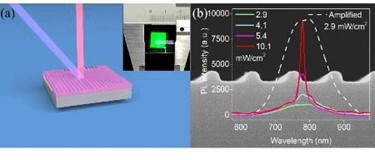Chinese Scientists Develop World's First All-Silicon Laser
By Jof Enriquez,
Follow me on Twitter @jofenriq

Scientists at Fudan University in Shanghai, China, have demonstrated the world's first optically pumped all-silicon distributed-feedback (DFB) laser, a key achievement toward realizing possibilities in integrated silicon photonics.
The development of an all-Si laser has proven challenging, mainly due to early versions having exhibited lower optical gains and lower efficiency than III-V compound semiconductors. Still, researchers have striven to create one because silicon has become the most promising material for integrated photonic circuits.
However, until recently, it still was not possible to create an all-Si laser. Meanwhile, a variety of other Si-based photonic components — such as optical waveguides, optical modulators and photodetectors — all have been demonstrated successfully.
It took a trio of exceptional steps for the research team to create the world's first all-Si laser.
First, they developed a film growth technique for high-density silicon nanocrystals in order to significantly enhance the Si emission intensity.
Second, they developed an ingenious high-pressure, low-temperature passivation approach.
"Compared with normal-pressure hydrogen passivation at higher temperatures (>500 C), a prolonged high-pressure passivation at relatively low temperatures contributes a full saturation of dangling bonds, leading to increased optical gains which are even comparable to those achieved by gallium arsenide (GaAs) and indium phosphide (InP)," stated the researchers.
Third, they designed and fabricated a distributed feedback (DFB) resonance cavity using the high-gain Si nanocrystals, and the lasing emission was observed by optical pumping with femtosecond pulses. DFB cavities are a common feature in semiconductor lasers and possess extreme compatibility with integrated semiconductor techniques.
"Lasing characteristics – the threshold effect, the polarization dependence, the significant spectral narrowing and small spread of divergence angle of stimulated emission - were fulfilled, suggesting the realization of an optically pumped all-Si laser," states the research team’s press release.
Moreover, the optically pumped all-Si laser could lead to the development of electrically pumped all-Si lasers.
This breakthrough of demonstrating the first all-Si laser will bring about a "technological revolution" in a variety of fields, including communications, sensing, lighting, display, imaging, and detection, according to the research team.
An all-silicon laser based on silicon nanocrystals with high optical gains was published recently on Science Bulletin by researchers Dong-Chen Wang, Chi Zhang, Pan Zeng, Wen-Jie Zhou, Lei Ma, Hao-Tian Wang, Zhi-Quan Zhou, Fei Hu, Shu-Yu Zhang, Ming Lu, and Xiang Wu, who received support from the National Natural Science Foundation of China and Shanghai Sailing Program.
